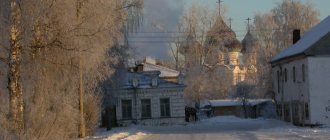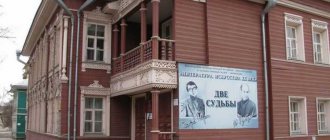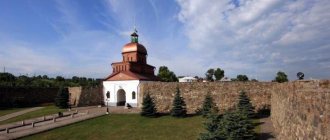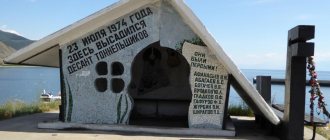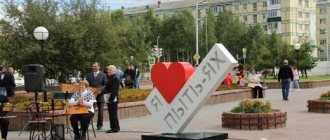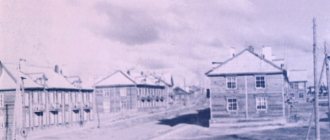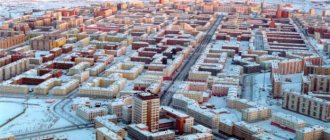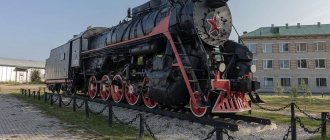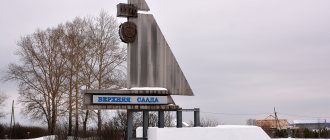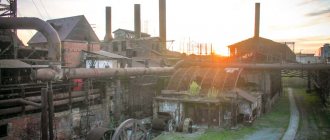- August 11, 2019
- Directions
- Molton
Does everyone know where Irkutsk is? Irkutsk is a large Russian city located in the southeastern part of Siberia, on the banks of the Angara River. It is the capital of the Irkutsk region. The population is 623.5 thousand people. Density – 2252 people/km².
Irkutsk is an ancient city. It was founded in 1661. Thanks to this, it became a candidate for inclusion in the UNESCO World Heritage List. Irkutsk is a major scientific and educational center. Sectors such as hydropower, aircraft manufacturing and food production are developed here.
Where is Irkutsk on the time zone map? Time in Irkutsk corresponds to Chinese (time zone UTC+8). The time difference between Irkutsk and Moscow is 5 hours. It's not that much.
The coat of arms of Irkutsk was approved in 1997. It is a heraldic shield of silver color. It depicts a black “babr” holding a scarlet sable in its mouth. Babr is a large, fierce and strong animal, which is classified as a member of the tiger family.
City on the Angara. General information and history of Irkutsk
Irkutsk (also Irk, Irkutsk) is a regional center, the largest city in the Angara region. It is located 5 hours flight from Moscow and an hour’s drive from Lake Baikal. In pretentious messages from local officials and other figures, it is often referred to as the “cultural capital of Eastern Siberia.”
Irkutsk from a bird's eye view
It is generally accepted that the history of the city began in 1661, when the Irkutsk fortress (fortress) was built on the right bank of the Angara. In 1686, the settlement received city status. By the way, in Irkutsk there is still no consensus on which date is considered more important. Therefore, just in case, both are celebrated: for example, in 1986 they celebrated the 300th anniversary of the city, and 25 years later, in 2011, the 350th anniversary.
Irkutsk received its name from the Irkut River, which flows in close proximity to it. Moreover, most of the city is located on the banks of another river – the Angara.
Irkutsk has always been a merchant city. All important trade routes from China passed through it. They brought sugar, tea, and fabrics. The poorest Irkutsk women at that time wore silk because it was much cheaper than cotton and linen. Furs were exported from Irkutsk itself.
Due to the harsh climate, life in Irkutsk has always been considered a punishment. Those who had offended the state were regularly sent here to hard labor or to settlement. The most famous exiles were the Decembrists, who made a fairly significant contribution to the development of Irkutsk as a cultural center. In order not to get bored in exile in the provinces, active and energetic Decembrists took up the task of educating the local population: they organized schools and taught people to read and write.
Winter on the Angara
In 1890, Chekhov visited Siberia. In his travel notes, he called Irkutsk an “intellectual city,” and now this is necessarily mentioned in all historical references. By the way, while here, the writer paid attention not only to cultural institutions, but also visited bathhouses and women of easy virtue.
During the Civil War, Kolchak’s government was located in Irkutsk, but upon arrival in the city he himself was arrested and shot. One of the local legends is associated with Admiral Kolchak. In 1919, a White Guard train allegedly loaded with gold fell into Lake Baikal. No one has yet managed to find the mythical “Kolchak’s gold”. However, how to refute the fact of its existence.
The Great Patriotic War became another cultural breakthrough for Irkutsk. Many scientists, professors, and academicians arrived here from the central regions of the country. Here they taught at universities and laid the foundations of classical Irkutsk education.
The industrial boom began after the war: its own hydroelectric power station was built, several factories appeared, including an aircraft factory. Not all of them were able to survive the 90s, but some are still working successfully. The city continues to develop both industrially and culturally.
Mountain system of the Irkutsk region
The Irkutsk region is located in the southeast of the Central Siberian Plateau, the ridges and plateaus of which rise to a height of 500 to 1,000 meters above sea level. In total, there are about 590 mountains of different heights and origins in the Irkutsk region.
Photo source - wp.com
From the south, the Irkutsk region and Irkutsk are surrounded by the Eastern Sayan mountains: Udinsky, Gutarsky, Biryusinsky and other ridges, with a height of up to 2,875 meters. To the east, the mountain landscape is more diverse. The Baikal Mountains are represented by the northern slopes of Khamar-Daban, with a height of 2,374 meters, the Primorsky ridge with a height of up to 1,728 meters, the Baikal ridge up to 2,572 meters in height, the North Baikal and Patom highlands, the western side of the Kodar ridge.
From -50° to +35°. Climate and ecology of Irkutsk
As mentioned above, the climate in Irkutsk is harsh - sharply continental. This provides the city with severe frosts in winter and heat in summer. Depending on the season, heavy snowfalls and heavy downpours are common. It is noteworthy that such vagaries of weather always come as a surprise to Irkutsk utility workers: snow almost completely blocks roads and passages, and rainwater floods everything around; storm sewers cannot cope with it.
After a rainstorm in Irkutsk
It still snows in Irkutsk in April. It also happened that he walked on May 25th. City residents are usually not surprised by such phenomena and even encourage creativity:
The end of spring and summer are coming. The suburb is drowned in green foliage. All this is Krasnodar, and I live in Irkutsk. I’ll go and sit down in a snowdrift!
The proximity of Baikal provides the city with constant seismic activity. Small earthquakes with a magnitude of 2-3 occur here at least once a month. Usually they scare only the most impressionable or those who have recently lived in Irkutsk. Everyone else is already used to them.
A little about ecology. According to scientists, Irkutsk is included in the list of the 35 most environmentally unfavorable cities in the country. The main source of pollution is car exhaust gases (the number of cars in Irkutsk is constantly growing), as well as some local enterprises, for example, thermal power plants and aircraft factories.
Smog over Irkutsk
It is interesting that the environmental problem of Irkutsk worries its residents very little. It is generally accepted here that as long as Baikal is the cleanest place on the planet, nothing threatens the city either. But everyone is worried about the safety of the lake: the city has repeatedly held rallies against the construction of an oil pipeline on Baikal, as well as against the Baikal Pulp Mill (BPPM), which dumps production waste into the lake. It was possible to save the lake from the oil pipeline, but the issue with the BPPM remains open.
Coat of arms
The coat of arms of Irkutsk is presented in the form of a French shield. On a silver background there is a black babr (panther, tiger) with red eyes. In his mouth he holds a scarlet sable. An animal with raised front paws is on green firmament. It faces the viewer's right. The feline predator is a symbol of the territory in which it lives. The extraction embodies the ancient craft of making products from valuable fur.
The artistic composition was approved on October 31, 1996. Included in the State Heraldic Register of the Russian Federation under No. 132.
Population of the city: who lives in Irkutsk?
According to data at the beginning of 2014, 613 thousand people live in Irkutsk. Among them are representatives of 120 nationalities: Russians, Ukrainians, Buryats, Tatars, Poles, Germans, Belarusians and many others. Mixed marriages are common. Orthodox churches and temples, a Catholic cathedral, a Polish church, a mosque, a synagogue and a Buddhist datsan coexist perfectly in the city.
From the early 90s to the mid-2000s, the population of Irkutsk was steadily declining: the birth rate was falling and the mortality rate was increasing. People were leaving the city. In recent years the situation has changed for the better.
There is a tendency towards an increase in the birth rate, and the natural increase, although not by much, exceeds the natural decrease. The population is also growing due to visitors: residents of surrounding villages and labor migrants from the CIS countries and China come here. Foreigners usually stay here illegally and work on construction sites and markets.
The average age of citizens in Irkutsk is 36 years. This is slightly less than the Russian average due to the large number of students. More than 100 thousand people are currently studying in universities and colleges in the city. Unfortunately, many young specialists cannot find employment in Irkutsk and leave for Moscow, St. Petersburg or large Siberian cities. Local authorities cannot yet figure out how to keep talented young people here.
Chekhov’s opinion that Irkutsk is an “intellectual city” is still relevant. There are many educated people here, and intellectual circles believe that Irkutsk is much more cultural than the “proletarian” Novosibirsk and Krasnoyarsk. At the same time, it is not customary here to love your city; it is often criticized and compared with the same Novosibirsk and Krasnoyarsk, which, being “proletarian”, have already solved the social problems that still face “cultural” Irkutsk. For example, the quality of roads and public transport, the pace of housing construction, youth employment.
This criticism often borders on pessimism and depression. In Siberia, Irkutsk leads in the number of suicides. Experts explain that people commit suicide because of their low standard of living and because they see no prospects.
Irkutsk residents, like all Siberians, are not too open and friendly. This is due to the secrecy of character, and not to rudeness or anger. Upon closer inspection, they turn out to be responsive and hospitable. Irkutsk residents know how to sympathize and are always ready to help.
Another interesting fact is that Irkutsk ranks second in the list of opposition cities in Russia (after Vladivostok). For this, the Irkutsk region received the status of a “red” or “protest” region. They do not support the current government and the ruling party here, rightly believing that the region contributes more to the federal budget than it receives from it.
Mount Chersky
Photo source - angara.net
The mountain is located at the sources of the Molokon, Irel and Kurkula rivers, and is the highest point of the Baikal ridge, which is almost 300 kilometers long. The height of Mount Chersky is 2,588 meters above sea level. It is characterized by altitudinal zones, where pine forest and forest-steppe predominate up to 1,000 meters, dark coniferous taiga above and larch woodland above 1,400 meters.
The mountain was named, like Peak on the Khamar-Daban ridge and Mount Kamen near the village of Listvyanka, in honor of the famous explorer of Eastern Siberia - I.D. Chersky. The mountain is loved by many travelers and climbers. Even for experienced climbers, climbing Chersky Peak is considered prestigious - a climbing route of the second category of difficulty has been laid to the top.
Districts and real estate of Irkutsk
Map of Irkutsk
The Angara River divides Irkutsk into two parts: the right bank and the left bank. They are connected by a hydroelectric dam and bridges: Old, New and Newest (aka Academichesky). Things didn’t work out with the names of the bridges: when in 1978 the bridge was given the name New, they didn’t think that the ones following it would also need to be called something. Therefore, the bridge, opened in 2010, has already become the newest. Officials tried to rectify the situation and renamed all bridges Glazkovsky, Innokentyevsky and Academichesky. But only the last name has stuck, and the rest are used extremely rarely, and the townspeople themselves get confused about them.
The newest bridge in Irkutsk
A special feature of Irkutsk is the private sector. Unlike most modern cities, where private houses are preserved only on the outskirts, in Irkutsk they are everywhere. Including in the city center. Wooden huts in the middle of a block of high-rise buildings are not uncommon here, but a common sight. You can walk through the city center and hear dogs barking, roosters crowing, and through a gap in the fence you can see someone’s vegetable garden with greenhouses. In Irkutsk they call this “preservation of ancient monuments” and they are not going to get rid of them.
However, even if they did, it would be difficult to do so: land in the city is very expensive and it is almost impossible to buy it from the owner at an adequate price. The residents of the huts also do not agree to resettlement. They understand that a new apartment in a high-rise building will never cost as much as their rickety house with amenities on the main street of the city.
One of the old houses in the city center
Let's go back to the beginning. So, the Angara divides Irkutsk into two banks. The right one is the historical and administrative center of the city. It houses all the buildings of the city and regional administrations, as well as most of the business and shopping centers, the bus station and the airport.
On the left there are industrial facilities and residential areas. The road from one bank to the other does not take much time, so it often happens that a person lives on one bank and works at the end of the other.
Kirovsky and Kuibyshevsky districts
In the center of the right bank are the Kirovsky and Kuibyshevsky districts. These are the most beautiful areas of the city; all the historical buildings, museums and theaters, several cinemas and clubs are concentrated here. The streets are full of green spaces, flower beds and interesting monuments. There are many public gardens, some of them have fountains. There are restaurants and other catering establishments at almost every step. Not all of them are expensive, some are quite affordable.
Lots of shops and shopping centers. The administrative and academic buildings of almost all Irkutsk universities are located here. Since these places are often visited by foreign tourists, all street name signs are translated into English. Also, for their convenience, there are billboards with maps and instructions on how to get to this or that attraction in the city center.
Center of Irkutsk
Almost no new housing is being built here, and secondary housing is expensive, even by national standards. The price per square meter can reach 68 thousand rubles. That is, an average 2-room apartment will cost no less than 3 million rubles.
Oktyabrsky district
Oktyabrsky is adjacent to the Kuibyshevsky and Kirovsky districts. Formally, this area does not belong to the central part of the city, but it contains the largest city street - Baikalskaya, which significantly enlivens it. In addition, the Akademichesky Bridge interchanges are located here. Now you can travel along it only by personal transport or by taxi; public transport is not yet open. However, once this happens, the area will become even more convenient for living and working. It is even possible that in time there will be a city center here.
All this, of course, makes the area more popular and housing in it more expensive. So far, the average price per square meter there is 55 thousand rubles. Or 2.4 million for a 2-room apartment.
Oktyabrsky district of Irkutsk
The infamous Irkutsk airport is located in the same area. In 2006, an Airbus A-310 crashed into garages while landing, went off the runway, and caught fire. Of the 204 people on board, 124 died. For several years in Irkutsk they have been trying to start building a new airport outside the city, but the project has not yet gone beyond the project.
Separately, it is worth mentioning Solnechny, the youngest microdistrict of the city. It is part of the Oktyabrsky district, but in fact it is a small city within the city: there are only new houses, high-rise buildings, and no private sector at all. Since the area is far from the center, the air here is cleaner.
In the microdistrict itself there is SibExpoCenter, an exhibition site where interesting thematic exhibitions are constantly running, as well as various sales fairs. In Solnechny there is a technical school of physical education, in the pool of which anyone can swim, as well as the Gold gym sports center. In the near future, a huge water sports complex will appear there, the construction of which is being carried out by Gazprom.
And another important advantage of Solnechny is the cost of housing. Due to the fact that there are many new buildings there, it will cost somewhat less than in the center. At the same time, the journey from Solnechny to the center by bus will take no more than 25 minutes, and by car even less.
Solnechny microdistrict in Irkutsk
Directly behind Solnechny there are two cottage villages – Molodezhny and Solnechny-2. Small houses, townhouses or brick houses are being built there. The Molodezhny building was built quite a long time ago and does not sit very well next to the dormitory of the Agricultural Academy.
But Solnechny-2 is a real dream. The houses there seem to have come out of pictures from American magazines about the beautiful life. Green lawns, small fences and a view of the pier, where snow-white yachts and boats rock on the waves. Not life, but a fairy tale. But not everyone can afford it. The cost of a cottage in Solnechny-2 starts from 11 million rubles. For about the same money you can buy a nice cottage in the Moscow region.
Solar
Let's move to the left bank. There are two large districts there - Sverdlovsky and Leninsky.
Sverdlovsk district
Young people prefer to settle in the Sverdlovsk region; more housing is being built here and it is more affordable than on the right bank (an average of 49 thousand per square meter). The area itself consists of several modern microdistricts, each of which has kindergartens, schools, and shops. Several universities are also located here. For example, a polytechnic university, an institute of the Ministry of Internal Affairs, a law institute, the Academy of Justice and others.
Irkutsk Akademgorodok
The Akademgorodok microdistrict (abbreviated as Akadem) stands out somewhat from the general row. It appeared earlier than the others and was built for employees of the Irkutsk Scientific Center of the Russian Academy of Sciences. It is still considered to be one of the most prosperous and peaceful neighborhoods. It has many small groves and squares, which makes it very cozy and picturesque. Nowadays, the Academy still houses several scientific centers and research organizations, but not only academicians and professors live there anymore.
Leninsky district
And finally, Leninsky district. It consists of two districts: Novolenino and Irkutsk-2 (pronounced “second Irkutsk”), as well as the villages of Zhilkino, Bokovo, Veresovka, Kirov and Gorky, which at different times became part of the district. It is believed that these areas have the most gopniks and it is better not to go there unless absolutely necessary. Especially in the dark. There may be some truth in this, but now the population of these areas is slowly changing. Young visiting families willingly settle there, buy apartments or rent them.
Housing prices are relatively affordable - an average of 44 thousand rubles per square meter. A standard 2-room apartment will cost 1.9 million.
Irkutsk Novolenino
These are the most promising areas in terms of construction of new housing and infrastructure development. Leninsky district is already ahead of all others in terms of birth rates and population growth rates. Therefore, first of all, new kindergartens and clinics are built there. Fortunately, there is enough space.
The Leninsky District is quite remote from the city center, but public transport between them is so good that going to Novolenino or Irkutsk-2 can be easier than getting from one central district to another. The issue of transport is especially relevant for residents of Novolenino. They mostly work downtown and commute back and forth daily. While almost the entire population of Irkutsk-2 is employed at the aircraft plant, which is located there. This is also a kind of city within a city: they have their own city-forming enterprise, their own holidays (Aviation Day) and even their own airport. True, it is used only for testing aircraft built at the aircraft factory.
Irkutsk Aircraft Plant
We can say that Irkutsk is so diverse that in one area you can have an apartment in a high-rise, and in another - a dacha with a vegetable garden and a view of the Angara. Not even that. You can have an apartment and a dacha across the street. Well, it’s convenient.
Cape Burkhan
Photo source - fotokto.ru
The cape, better known as Shaman Rock, is located in the central waters of Lake Baikal, near the village of Khuzhir. This is one of the most recognizable places from the lake; not a single tourist leaves the lake without a photo.
The double-peaked rock is distinguished by the bright red lichen at the top, and the mountain is limestone with small inclusions of quartz and marble. The rock is pierced by a through cave more than 10 meters long, where in the past the Buryats performed shamanic rituals. With the advent of Tibetan Buddhism, the indigenous population began to call the main deity of the lake with the word “Burkhan”, and the rock as his home.
Cape Burkhan with the cave is considered one of the main 9 Asian shrines, revered by all religions. The site is known for many archaeological finds from the Neolithic era to modern times. Some of the hundreds of unique artifacts are kept in the Khuzhir Museum.
Infrastructure of Irkutsk: “It would be better if they built a kindergarten!”
The most pressing problems of Irkutsk are the shortage of places in kindergartens, the quality of roads and the state of public transport. Let's talk about each one separately.
Today in Irkutsk there are almost 26 thousand children on the waiting list for a place in kindergarten. The authorities are trying to solve the problem: they are opening additional groups and building new buildings. However, these measures provide at most 400 new places per year. This is a drop in the ocean compared to the figure of 26 thousand. Many parents are forced to send their children to private kindergartens and pay 10, 15, or even 20 thousand a month for them. For comparison: a municipal kindergarten costs a family 1,300 rubles. The townspeople rightly note that in this situation, you need to think seriously before acquiring offspring. Note that there is no such problem with schools. There are quite a lot of them, and you can choose any one.
Let's go back to the kindergartens. At one time, the phrase “It would be better if they built a kindergarten!” was very popular in Irkutsk! It was used to respond to all the initiatives of the city authorities: “New squares and fountains will appear in Irkutsk” - “It would be better if they built a kindergarten!”, “Officials took part in the cleanup work” - “It would be better if they built a kindergarten!”. And so on in the same spirit. As a result, the completely exhausted mayor made a strong-willed decision: to spend the entire annual capital construction budget on kindergartens. It would seem that the goal has been achieved, you can calm down. But no: now Irkutsk residents demand good roads.
By the way, the roads in Irkutsk have always been bad. Recently, they have been undergoing frequent and lengthy repairs in preparation for the 350th anniversary. Sometimes they were in such a hurry that they laid asphalt in the rain and even in the snow. We spent a lot of money. In the end, it turned out well: both officials and car enthusiasts were satisfied. But in the spring, the asphalt disappeared from the roads along with the melted snow: new cracks and holes appeared. Nothing else reminds us of the grandiose renovation. Everything needs to be done anew, but the city no longer has money: it is all directed towards the construction of kindergartens.
Continuing the road topic, let's talk about public transport. In Irkutsk it is divided into two parts: municipal and private. Municipal services include trams, trolleybuses and large comfortable buses. The private one transports people on minibuses (aka “death capsules”) and on Korean buses, in which a decent Irkutsk resident simply cannot fit. The whole tragedy of the situation is that municipal transport runs much less often than private transport, its routes are not as long and convenient. And a private one, although it will take you wherever you need it, does not guarantee the safety of passengers: hot drivers from Central Asia organize real races on the roads, cutting each other off, and braking sharply. It’s especially chic to open the doors while driving or let passengers out in the second row of traffic. You will also have to forget about comfort during the trip. Minibuses and Korean buses are always cramped and dirty, they don’t always smell good, and drivers are not averse to smoking while driving. At the same time, transport can fall apart on the move: through holes in the floor of some buses you can monitor the road, and the doors of minibuses have more than once remained in the hands of passengers who tried to close them. Yes, we were just having a blast.
Irkutsk minibus
At the same time, municipalities do not want to develop their routes, justifying themselves by the fact that private owners create great competition for them. And city authorities say that they cannot prohibit private owners from working, because antimonopoly legislation does not allow it. This is such a vicious circle.
So that it doesn’t seem that everything is completely bad in Irkutsk, we note that there are practically no traffic jams in the city, it seems to be the same as in other large cities. You can be stuck on the road for a maximum of half an hour and half a day. Traffic difficulties are usually associated with road repairs. For example, the construction of a new bridge interchange is now being completed in the center and therefore trips in that area take longer. However, everyone understands that a denouement is needed and bravely endures it.
Traffic jam on Baikalskaya street in Irkutsk
However, the traffic police regularly reminds that there are more and more cars in the city, and there is nowhere to expand the streets. So the traffic jam situation will get worse in the future.
There are no particular problems in the housing and communal services sector in Irkutsk. Major utility accidents are rare here. Tariffs for services are, of course, constantly growing, but not so much as to warrant protest. Citizens like to say: “Russia has the cheapest electricity in the world. Irkutsk has the cheapest electricity in Russia. This means we have the cheapest electricity in the world!” And this is true - thanks to the cascade of hydroelectric power stations on the Angara. They pay 68 kopecks per kWh for light here.
The cost of utilities depends on the size of the apartment and the number of registered people. For example, a family of 3 people pays 2,300 rubles monthly for a 2-room apartment. This amount may be less if the apartment has heat and water meters. However, not everyone in Irkutsk has yet appreciated their benefits and is in no hurry to install them.
Flag
The flag of Irkutsk is made in the form of a rectangular panel. Elements of the coat of arms are depicted on both sides. They are shifted towards the shaft. The ratio of the distance of the center of the babr image from the left edge to the length of the panel is 1:3. The ratio of the width of the blue stripe in the lower part to the height of the panel is 1:4. This is the only Russian flag that has a non-standard shape. The lower blue stripe ends with a slope (braid).
The artistic composition was approved by the decision of the City Duma of October 31, 1996 No. 3-29gD (2). Included in the State Heraldic Register of the Russian Federation under No. 133.
Enterprises and work in Irkutsk
The leading industries in Irkutsk are heavy engineering and food products. The city has its own dairy plant, meat processing plant, bakery, and oil and fat plant. There are private bakeries and confectionery shops. Mechanical engineering is carried out by the Irkutsk Heavy Engineering Plant (IZTM), which produces unique equipment for the development of deposits and gold mining.
An important role is played by the local energy complex, which is administered and includes local hydroelectric power stations and thermal power plants. Every year, the Irkutsk hydroelectric station produces about 4.1 billion kilowatt-hours of energy. This means that it could provide electricity to a small European state. In the meantime, all its power is used to supply the aluminum smelter in Shelekhov. And Irkutsk uses the energy of the Bratsk hydroelectric station.
Dam of the Irkutsk hydroelectric power station
The local aircraft plant is a source of real pride for Irkutsk residents. He builds aircraft for the Russian Ministry of Defense and for other countries: India, China, Malaysia, Algeria, Indonesia, Venezuela.
Personnel for local industrial enterprises are trained here in Irkutsk, mainly at the Polytechnic University. Smart graduates are hired with pleasure. But the young specialist is not threatened with a large salary. In the first years, the main income will be professional experience, which will later help you move up the career ladder.
Young people, however, do not strive to make a career in factories. Nobody wants to start as a simple worker. But they are happy to become waiters and salespeople; these places seem more rewarding to them. At the same time, practically not a single restaurant or store in the city officially employs workers and does not give them a social package. The same applies to private companies. Only public sector workers or employees of those organizations that value their reputation can boast of official employment in Irkutsk.
According to statistics, the average salary in Irkutsk is 24 thousand rubles. But this is the “average temperature in the hospital” - the arithmetic average between very large and very small salaries. Few city residents receive more than 20 thousand rubles. A salary of 25 thousand is considered good.
One of the most common professions in the city is sales manager. There is a great demand for specialists in this field in Irkutsk. This can be explained simply: Irkutsk still remains a trading, “merchant” city. There are a lot of shopping centers, supermarkets, shops here. Among them there are both large federal brands (Benetton, Savage, L'Etoile, Incity) and purely local ones (Slata, Caesar, Okay, Bonus, etc.). The largest complexes - "Jem Mall" and "Caramel" - include not only shopping pavilions, but also 6-screen cinemas. And the Jam Mall also has a roller skating rink and an indoor skating rink.
Shopping center Jam Mall
But the most interesting market in Irkutsk is Shanghai, Chinese shopping arcades. They are not arranged very neatly and are not very clean, but you can shop there much cheaper than in a store. They sell everything here: clothes, linen, dishes, toys, household appliances, carpets. Recently you can find cases for iPads there (with time, iPads themselves will probably appear). In addition, traders from neighboring settlements, the so-called “shuttles,” purchase goods in Shanghai. At home they sell this product at twice the price.
Shanghaika
Shanghai is located in the very center of the city and, of course, does not improve its appearance in any way. However, all attempts by the authorities to move the market to another location have so far been unsuccessful. The same situation has developed with the car market in the Rabochee suburb. Car enthusiasts have chosen this area for their transactions - buying and selling used cars. Residents of the surrounding houses do not like this at all; they are disturbed by the noise and exhaust fumes of cars. But it’s impossible to drive the traders out of Rabochy. At the request of the traffic police, the market stopped operating several times, but after a couple of days the cars were again standing in their usual places.
It should be noted that the Irkutsk authorities actively support small and medium-sized businesses. Entrepreneurs can take part in a special program and receive a loan to start or develop a business. The amounts are, of course, small, but it’s better than nothing at all. The offer is especially relevant for young entrepreneurs who are taking their first steps in business.
The restaurant business is considered the most promising and profitable in Irkutsk. Now there are almost 700 catering establishments operating in the city. Every year several more open, and almost all of them find their regular customers. Irkutsk residents are ready to spend money on good cuisine and service. But owning a restaurant is not a cheap pleasure: it requires substantial start-up capital and significant monthly investments.
In general, there is enough work in Irkutsk. It doesn’t lie under your feet, but you can always find it if you want. You can get a job as a loader in a supermarket, or you can open your own business. This already depends on the person’s personal ambitions, his abilities and plans for the future.
Cape Ryty
Photo source - x-material.ru
The cape on the western side of the central part of the Baikal water area is formed by river sediments from the river. Ryta and is located on the territory of the Baikal-Lena Nature Reserve. In the summer, the parched valley dries up and turns into an area riddled with narrow ravines. This determined the name of the cape. The valley is impassable due to a scattering of large stones that appeared as a result of debris flows into the lake.
Cape Ryty and the valley are considered an anomalous zone that knowledgeable people avoid. The intensity of the geomagnetic field is recorded here, and the explanation for this is a large tectonic fault passing through the territory. There are no excursion trails here, and access to the Ryta River valley is possible only with the permission of the administration.
Police and crime in Irkutsk: protect yourself
According to official police statistics, Irkutsk is not a crime-ridden city; no more crimes are committed there than elsewhere. However, it is not customary to trust the police here. This mistrust intensified especially strongly after a series of murders that occurred in Akademgorodok from December 2010 to March 2011. In four months, 6 people were killed. They were all beaten to death with a hammer or a bat. However, the local police until recently denied that a maniac was operating in the city. “The crimes are not connected in any way. There is no reason to talk about a maniac,” the official reports said. As it turned out later, the police were right in some ways. In Academy Town, indeed, it was not a maniac who was operating, but... two maniacs. The killers turned out to be 17-year-old boys, residents of the same Academy Town. After the arrest, they explained that by killing, they were clearing the planet of those who were not worthy of living on it. Strange, but even after this, psychiatrists recognized them as normal. Now the “hammer men” (as they were nicknamed for their favorite murder weapon) are sitting in a pre-trial detention center and awaiting trial.
While the police reassured the townspeople and said that there was no maniac, the residents of Academy Town decided to protect themselves. They formed several people's squads and patrolled the area in the evening and at night, escorting women and children home. The squads continued to work after the capture of the “hammer men”. City authorities and police strongly support this initiative. The residents of Irkutsk are also happy: they trust the vigilantes more than the police.
And in the winter of 2012 in Irkutsk they started talking about a maniac again. Coincidentally, two young guys disappeared in the city with a difference of 10 days. The first one was drinking at night with friends in a pub and left there in an unknown direction, the second one left the house during the day and never returned there.
Friends and relatives of the young men began an active search: they created groups on social networks, organized raids with volunteers, and posted advertisements with signs. All the media talked about the missing. As a result, there was so much information about this that the townspeople got the impression that people in Irkutsk were disappearing every day. Moreover, there are 10-15 people. The most incredible rumors spread throughout the city: supposedly young, healthy boys and girls were being kidnapped for their organs. Panic messages constantly appeared on the Internet about bodies found without kidneys and livers. Irkutsk residents urged each other to be careful and not walk alone. The police denied alarming rumors, citing statistics that people in the city were not disappearing more often than usual. However, it took a long time to calm the alarmists.
And the missing guys were found in the spring: the first froze to death drunk in a snowdrift in the cemetery, and the second hanged himself in the taiga not far from his home. He had problems with his studies, which he was afraid to tell his parents about. The young man did not find any other way out of the situation. The stories are sad, but very far from crime and the authorities.
Recently in Irkutsk there has been an increase in crimes related to the use of traumatic weapons. Some townspeople use it to resolve everyday conflicts. Thus, a student from one of the local universities fired at a school bus with which he did not share the roadway. Another driver shot at the minibus that cut him off (the minibus, by the way, calmly moved on after that). Another frostbitten man shot at a pedestrian who was crossing the road in front of his car.
However, the city also knows a positive example of the use of trauma: one motorist managed to detain a car thief with its help. The man caught the kidnapper in the act, and he tried to escape. Several accurate shots stopped him. The thief was immediately handed over to the police, and the owner of the injury became the hero of the day.
Mount Zhima
Photo source - peakfinder.ru
The highest peak of Olkhon Island, rising 1,274 meters above the sea, and only 818 meters above Baikal. The mountain is located on Cape Izhimei, not far from Cape Khara-Khushun, on the northern side of the eastern part of the island. It occupies the territory of the Pribaikalsky National Park.
The name of the mountain comes from the Buryat “ezhin”, which means “master of the area”. The rocky slope of Zhima from the island side is 30-40 degrees. Here, nearby, between Khara-Khushun and Izhimei, is the deepest section of Lake Baikal at 1637 meters. The west of the mountain is strewn with dense relic spruce forest.
The press is popular among climbers and tourists without professional training. Climbing the mountain cannot be called easy - you have to spend the whole day climbing a narrow path through a dense forest. However, from the top you can see a stunning view of the Big Sea, and on the other side of the Small Sea.
Healthcare.
There are 46 municipal healthcare institutions in the city, and 8 municipal medical programs. The Irkutsk branch of the Interdisciplinary Scientific and Technical Complex “Eye Microsurgery”, a Diagnostic Center, centers for alternative medicine, medical social, psychological and psychotherapeutic assistance have been created. In 1987, the East Siberian branch of the Siberian Branch of the Academy of Medical Sciences was opened in Irkutsk, designed to coordinate medical research at the regional level.
Rock Idol
Photo source - sputniknewslv.com
Somewhere on the slopes of the Olkhinsky plateau, where dense taiga forests make it difficult to see what is a few meters ahead, the idol rock Idol is hidden. Its appearance is reminiscent of the idols from Easter Island - the same column made of light pink roughly hewn granite at least 30 meters high.
In the 60s of the last century, the rock was popular among young climbers and many tried to conquer it. But only a few people managed to reach the top. After some time, the Vityaz rock, located nearby, captured the attention of the athletes and the place forgot its visitors. The Idol Rock is located surrounded by picturesque nature - ridges of pines and larches, on a stone plateau.
1. 130th quarter
The 130th quarter, or Irkutskaya Sloboda, is a unique historical landmark in the very center of Irkutsk, known for its colorful wooden buildings. The Irkutsk settlement began to be built up back in the 18th century, and at that time the basis of its architectural ensemble was made up of log peasant houses and rich merchant estates. Several years ago, for the city's anniversary, the historical buildings of the Irkutsk settlement were restored, and now the 130th quarter boasts many original old mansions with elegant window frames and elegant decorative carvings. The historical atmosphere of the Irkutsk settlement is perfectly complemented by the most interesting museums located on its territory: the Museum of the Siberian Railway, the Craft Compound and one of the departments of the Irkutsk Museum of Local Lore.
9. Taltsy
The architectural and ethnographic complex “Taltsy” on the banks of the Angara is a unique protected area of the Irkutsk region, by visiting which you can take a fascinating journey through time and get acquainted with the life of the indigenous peoples of the Baikal region. On the territory of the museum complex, ancient sites of Evenks and Buryats are adjacent to later Russian settlements of the 17th – 20th centuries. Here you can see ancient wooden churches, visit the parish school, look into the house of the city Cossack, admire the cascade of mills and watch the work of local craftsmen. The museum often hosts folklore festivals, celebrates national holidays on a grand scale, organizes tea parties at the samovar, and also hosts fascinating master classes on ancient crafts. The perfect end to the excursion will be a hearty lunch at the tavern, where you can taste traditional local dishes: stuffed pike, lingonberry pie and aromatic sbiten.
Construction.
In 2003, investments in fixed capital of enterprises and organizations of various forms of ownership in the city of Irkutsk amounted to 5358.5 million rubles (an increase of 66% compared to 2002). 57.7% of the total investment was used for the construction of industrial facilities. 42.3% of the amount went to municipal and housing construction, healthcare, education, culture, trade, science, etc. Residential buildings with a total area of 106 thousand sq.m. were put into operation by enterprises and organizations of various forms of ownership. (86% of the 2002 level).
Statistics by year
If we talk about the population of the city of Irkutsk, here is how it has changed over the past 170 years:
- In 1856, when the first statistical census was carried out, confirming 24,100 people.
- By the post-revolutionary year of 1923 it had increased to 88,264.
- In 1831 there were 113,215.
- By 1839 it had more than doubled - to 250.181.
- In 1956 it was 314,000.
- In 1962 - 385,000 people.
- Already in 1975, 516,000 people began to live here.
- By 1985 – 601,000.
- By 1990 - 582,000.
- In 1995, the number of living citizens decreased even further, resulting in a figure of 581,000.
- But for the 2000 calendar period, the composition here reached 593,700.
- In 2005 – 582,500.
- In 2010 – 587.891.
- In 2015 – 620.099.
- For 2022 – 623.479.
Over more than 170 years of history, the population has increased more than 25 times. True, at the same time it is worth noting that over the past 5 years, until 2022, it has remained virtually unchanged in number and density. The figure fluctuates around 623,000, showing periodic growth and then a short fall, within a few 100 people.
Kodar Ridge
Photo source - sentstory.ru
It is located in the Transbaikalia region and belongs to the Stanovoy Highland system. Its peaks rise above the Chara Basin, and the ridge itself is 250 kilometers long. More peaks are around 3,000 meters high, but the highest peak, called BAM, rises to 3,072 meters.
The ridge is created by crystalline schists and granite gneisses; deposits of copper and coal have been found here. The Kodar ridge belongs to the area of modern mountain building, so earthquakes are frequent here. The modern alpine landscape was formed under the influence of erosion, glaciation and tectonic activity.
A well-known, but not fully studied local phenomenon is glaciers that formed below the natural line of occurrence of snow and ice massifs. Moreover, their area is amazing - 12.3 km2.
Going out to explore the mountains of the Irkutsk region alone is not always a great option. Without knowing the area, you can waste precious vacation time looking for the most interesting and unique objects. The “Seven Days on Baikal” excursion is a real find for those who dream of exploring the lake and its islands and learning many legends, secrets, and walking along unknown paths. Just a week and a concentration of vivid impressions is guaranteed. One of several tourist centers on Olkhon with a picturesque view of the Baikal nature is perfect for accommodation. Moreover, when ordering an excursion tour or accommodation, you can get your money back for your vacation as part of the “20% Cashback for Traveling in Russia” promotion.
Like Like Love Funny Surprised Sad Angry
200000
2
Our project is developing thanks to you!
If the article turned out to be useful, you can support our editorial team in difficult days for tourism (the amount can be any).
